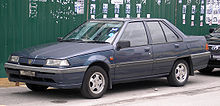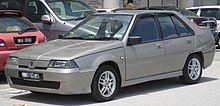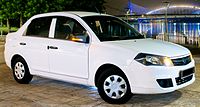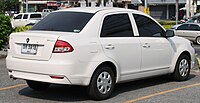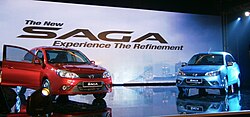Proton saga
| Proton saga | |
|---|---|
| Production period: | since 1985 |
| Class : | Compact class |
| Body versions : | Limousine , station wagon |
The Proton Saga is a notchback sedan based on the Proton Savvy and has been built by the Malay car manufacturer Proton since 1985. The name Saga was chosen in a competition won by the former soldier Ismail Jaafar . The name is derived from the paternoster pea (English: saga; lat .: Abrus Precatorius), a legume found in Malaysia that is soft, fragile, oily, easily inflammable, but very fertile. In some countries the Proton Saga is also known under the name Proton S16.
The saga and its descendants have been the source of most of Proton's sales and revenue since its inception. At almost 22 years of age, the first-generation saga is still the longest-lasting Proton model, ahead of the mid-range Perdana . The first Saga model was based on the Mitsubishi Lancer from 1983 to save development costs, and it stayed that way throughout the production period. In 2008 a long-needed successor in-house came out that replaced the outdated platform. In August 2008, the three millionth Proton was made, a second generation saga.
Saga (1985-2008)
| 1st generation | |
|---|---|
|
Proton Saga (1985-1990) |
|
| Production period: | 1985-2008 |
| Body versions : | Limousine , station wagon |
| Engines: |
Petrol engines : 1.3–1.5 liters (51.8–55 kW) |
| Length: | |
| Width: | |
| Height: | |
| Wheelbase : | |
| Empty weight : | 940 kg |
Saga (1985-1992)
The Proton Saga came out in September 1985 and was introduced by the then Malay Prime Minister Mahatir Bin Mohamed . Before production started, a competition was held to determine what the name of the first Malay car would be.
The first saga to leave the assembly line was given to the National Museum of Malay as a symbol of the dawning automotive history of Malaysia. The Prime Minister also drove a prototype of the Proton Saga, equipped with a 2.0L 4G63 engine and a flag of Malaysia , over the new bridge to Penang Airport for the opening ceremony of the Penang Bridge on September 14, 1985 .
The early models were Saga of a four-cylinder SOHC -Reihenmotor of Mitsubishi driven, which was obtained with 1.3 liters or 1.5 liters. Both engines could be combined with a manual five-speed gearbox, but from 1987 there was also a three-speed automatic transmission from Mitsubishi for the 1.5-l version.
In 1988 a hatchback variant as Proton Knight (later Proton Aeroback ) was added. The Proton Knight was meant for European markets, because especially in the UK , the Station Wagons were popular.
In 1989 Proton offered the saga in the UK with the slogan Japanese Technology + Malaysian Style = Proton (German: Japanese Technology + Malay Style = Proton). Since then, the UK has been Proton's main export market. The cars were not called Saga, but simply "Proton 1.3" and "Proton 1.5". The models for the United Kingdom got the dashboard of the Mitsubishi Lancer again with all the switches that were not available on the domestic models.
In 1990 the series was revised with the introduction of the 12-valve Megavalve engines; the output of the 1.5 l engine increased from 70.5 bhp (52.6 kW) to 75 bhp (56 kW). On the domestic market, the new model even featured the inscription “Megavalve”. At the same time, the exterior was changed slightly: a new radiator grille and black decorative strips that gripped the vehicle corners were added. Seat belts on the rear seats and a third brake light were now installed as standard.
Saga Iswara (1992-2008)
In 1992 the saga got another facelift and was renamed Proton Saga Iswara (also: Proton Iswara ). The name Iswara is derived from a species of butterfly from Sarawak . The changes included slimmer headlights, plastic bumper, side moldings, door handles painted in body color, ribbed taillights and a license plate light now moved to the bumper. There were also new exterior colors for the automatic models. These models in particular are often used as taxis in Malaysia and some have been converted to natural gas . Because of this retrofit, the trunk volume has been halved so that there is space for the additional tank and there are only a small number of gas stations of the Malay oil giant Petronas in the Klang Valley (Greater Kuala Lumpur ) that sell natural gas, even if there are plans to do so Significantly increase the number of gas stations in Kuala Lumpur.
The export models for Singapore and the United Kingdom were equipped with multi-point injection (MPI) and catalytic converter and met the Euro I emissions standard . With the introduction of the Wira in 1993, the corresponding Saga models were replaced in the United Kingdom and the generation change was completed in 1996.
In 2001 Proton introduced a special model of the Saga Iswara Sport based on the Aeroback in order to be able to compete with the domestic competitor Perodua . This model was equipped with a new body package, rear fenders with metallic paint, headlights with "jewel effect", Altezza rear lights (with clear cover and inserted, colored individual lights ), and other improvements. This model was only available with a silver paintwork, automatic transmission and 1.3-liter engine. The actual Saga Iswara Aeroback was still available with a 1.5-liter engine.
The Iswara Aeroback was further modified in the domestic market from 2003 and became the Saga LMST , while the sedan continued to be built unchanged.
The sedan version of the Saga Iswara has been the preferred taxi model in Malaysia since the 1990s, as you can see from this example from Kuala Lumpur .
Saga (2003-2008)
In 2003 Proton gave the Iswara, so to speak as the successor to the Saga Iswara Sport special model, another facelift and renamed it Saga again. This generation is known as the Saga LMST . Inside there was a completely new dashboard, new door panels and an instrument set with a digital display, which included an odometer , a fuel gauge and a temperature gauge. Outside the car got new headlights and taillights, as well as bumpers and exterior mirrors in the same color as the car. Proton used the 1.3-liter carburettor engine again, which - equipped with a new exhaust system - now developed 83 bhp (62 kW). This model was only available with a manual five-speed gearbox.
On March 5, 2007, Proton launched the 50th Merdeka Anniversary Promotion , where a new price was announced for the Saga, RM 26,999. The famous song Sexyback by Justin Timberlake was used in the advertising campaign for the Aeroback saga , with the text changed to "Aeroback". The advertisement served to support the 50th anniversary of Malay independence (Merdeka) and also as a thank you to Proton customers who had bought the saga in large numbers since its first appearance. This campaign was also an attempt by Proton to steal potential buyers for its new small car Perodua Viva from its domestic competitor Perodua . That year, the Proton Saga became the second best-selling car model in Malaysia after and the best-selling sedan in Malaysia with approximately 15,000 orders. This version is the fastest and lightest version of the saga Proton has ever made. However, there have also been many customer complaints about this car relating to interior defects, e.g. B. broken switches for the electric windows or uncontrolled operation of the air conditioning. The reason for these shortcomings was the practice of Proton not to carry out its own strict quality tests in order to satisfy the high demand for this model during the advertising campaign.
Saga (2008-2011)
| 2nd generation | |
|---|---|
|
Proton Saga (2008-2011) |
|
| Production period: | 2008-2011 |
| Body versions : | limousine |
| Engines: |
Petrol engines : 1.3-1.6 liters (69-84 kW) |
| Length: | 4257 mm |
| Width: | 1680 mm |
| Height: | 1502 mm |
| Wheelbase : | 2465 mm |
| Empty weight : | 1060-1085 kg |
On January 18, 2008, Proton introduced the successor to the 2007 Saga, which should be discontinued in June 2008. It kept the name Saga and should surpass its predecessor in every respect. Its body essentially corresponds to that of an elongated Savvy . The new model is a Proton-owned construction, which was developed together with the LG Group from South Korea and the subsidiary Lotus Engineering . This model enables Proton to showcase its strengths in the home market, especially in notchback sedans. The new saga is not supposed to be exported to the USA, but to many countries in Southeast Asia, China , India and Australia .
By February 2008, this model had been ordered around 23,000 times and the delivery time was five months.
In July 2009, an electrically powered version of the Saga was demonstrated at the University of Malaysia in Penang.
Equipment variants
The Saga is available in three different equipment variants, with manual or automatic transmission, from the basic N model to the fully equipped M model. Aichi Kikai supplies the manual transmission, while the automatic transmission comes from Mitsubishi . The base model N costs RM 31,500, the top model M RM 39,800. The new Saga will be the cheapest Proton model as soon as the original Saga model is discontinued for RM 26,999. Proton calls the new saga “The People's Car” (German: Volkswagen).
Engine and performance
The new Saga is powered by the same 1.3-liter Campro engine (designed together with Lotus Engineering ) that is installed in the entry-level Gen-2 . Like the other proton models that are driven by this motor, also developed the Saga 94 hp (69 kW) at 6000 min -1 and a torque of 120 Nm at 4000 min -1 . The engine has the new air control system (IAFM), which regulates the air supply according to the fuel supply, thus reducing fuel consumption and overcoming the well-known weak torque of the Campro engine in the medium speed range. The ignition system has also been redesigned so that the ignition coils are now sitting directly on the spark plug connectors. The power delivery of the engine is different to the Satria Neo , which still has an engine without IAFM. One feels a strong torque 2500-4000 min -1 . The five-speed gearbox from Aichi Kikai is not optimally designed for top speed, but delivers good torque over the entire speed range and also offers acceleration reserves when overtaking in the speed range 80–120 km / h. The front wheels are suspended from MacPherson struts with wishbones and stabilizers; there is a torsion beam axle at the rear . This suspension, designed by Lotus, helps the car to corner neutral without understeer. The fuel consumption of the manually operated car is also relatively low at around 6 l / 100 km.
In addition to the 1.3-liter engine, there is also the 1.6-liter Campro engine, but only for taxis. This engine is also equipped with IAFM and develops 114 bhp (84 kW) at 6500 min −1 and a torque of 148 Nm at 4000 min −1 . The top model (currently the M model) is equipped with 14 ″ wheels and 185/65 R14 tires for improved traction, which gives the vehicle shorter braking distances and better tracking. However, it is not equipped with ABS .
Interior
The new saga, like its predecessor, is set to become the standard for Malay taxi drivers. However, the car is not designed to accommodate an additional natural gas tank. A Malaysian Orange Taxi Company , Innovasi Timur Sdn Bhd , installed a better natural gas system with a different tank that leaves trunk space for passengers' luggage. The car is larger than the old saga and has enough space for five Malay adults. In the M model there is an airbag for the driver. Since the Saga was designed as a vehicle for the city, the air conditioning has been designed to be stronger and more efficient than on the previous model, even when the engine is idling.
Awards
Since the launch of the second generation of the new Saga in January 2008, the car has won three major awards for automobiles. Autocar Asean , the Malay edition of the oldest car magazine in history, honored the new saga as the winner in the small sedan / station wagon category in 2008 . Shortly thereafter, the car was voted Best Car for the People in the Asian Auto - VCA Auto Industry Award 2008. In November of the same year, the new Saga won yet another major Malay automotive competition and was named the entry-level vehicle winner at the New Straits Times / Maybank Car of the Year Awards 2008. On May 13, 2010, Frost & Sullivan awarded the saga the Best Passenger Car of the Year award for its quality and reliability.
Saga FLX (2011-2016)
| 3rd generation | |
|---|---|
|
Proton Saga FLX (2011-2016) |
|
| Production period: | 2011-2016 |
| Body versions : | limousine |
| Engines: |
Petrol engines : 1.3 liters (70 kW) |
| Length: | 4278 mm |
| Width: | 1680 mm |
| Height: | 1520 mm |
| Wheelbase : | 2465 mm |
| Empty weight : | 1048-1075 kg |
The third generation of the saga is based on the second generation. The sedan is still powered by the 1.3-liter four-cylinder engine from the previous model, which developed 70 kW (94 hp). As an alternative to a manual transmission , a continuously variable transmission is available.
Technical specifications
| 1.3 | |
|---|---|
| Construction period | 2011-2016 |
| Engine characteristics | |
| Engine type | R4 petrol engine |
| Displacement | 1332 cc |
| Max. Power at min −1 | 70 kW (94 PS) / 5750 |
| Max. Torque in min -1 | 120 Nm / 4000 |
| Power transmission | |
| drive | Front wheel drive |
| Gearbox, as standard | Manual transmission |
| Gearbox, optional | ( Stepless gear ) |
| Readings | |
| Top speed | 160 km / h (155 km / h) |
| Acceleration, 0-100 km / h | 13.0 s (14.5 s) |
| Fuel consumption over 100 km (combined) | 5.7 l super (6.0 l super) |
| Tank capacity | 40 l |
Saga (since 2016)
| 4th generation | |
|---|---|
|
Proton Saga (since 2016) |
|
| Production period: | since 2016 |
| Body versions : | limousine |
| Engines: |
Petrol engines : 1.3 liters (70 kW) |
| Length: | 4331 mm |
| Width: | 1689 mm |
| Height: | 1491 mm |
| Wheelbase : | 2465 mm |
| Empty weight : | 1035-1080 kg |
The fourth generation of the Saga is based on the platform of the previous Saga FLX, from which it also takes over the engine. It was presented in Shah Alam on September 28, 2016 . As an alternative to a manual transmission , a continuously variable transmission is again available.
Technical specifications
| 1.3 | |
|---|---|
| Construction period | since 09/2016 |
| Engine characteristics | |
| Engine type | R4 petrol engine |
| Displacement | 1332 cc |
| Compression ratio | 10.0: 1 |
| Max. Power at min −1 | 70 kW (95 PS) / 5750 |
| Max. Torque in min -1 | 120 Nm / 4000 |
| Power transmission | |
| drive | Front wheel drive |
| Gearbox, as standard | Manual transmission |
| Gearbox, optional | ( Stepless gear ) |
| Readings | |
| Top speed | 160 km / h (155 km / h) |
| Acceleration, 0-100 km / h | 12.2 s (13.1 s) |
| Fuel consumption over 100 km (combined) | 5.4 l super (5.6 l super) |
literature
- KS Jomo: The Proton Saga . In: Japan and Malaysian Economic Development: In the Shadow of the Rising Sun . Routledge, 2006, pp. 263 (English).
Individual evidence
- ^ First National Car Reborn . YouTube.com. Originally from the Malay newspaper "The Star"
- ↑ First Looks: The New Proton Saga . Malaysian Motor Trader. January 18, 2008 ( Memento of the original from January 20, 2008 in the Internet Archive ) Info: The archive link was inserted automatically and has not yet been checked. Please check the original and archive link according to the instructions and then remove this notice.
- ↑ Wan Syamsul Wan Seadey: Proton Saga RM 26,999 sempena 50 tahun merdeka . Utusan Malaysia. March 5, 2007 (Malay)
- ↑ a b c d e Amery Reuben: Road Test: Proton Saga 1.3 M . sgcarmart.com. September 1, 2008 (english)
- ↑ Inaugural Asian Auto-VCA Awards takes off . Star motoring. July 23, 2008 ( Memento of the original from January 8, 2009 in the Internet Archive ) Info: The archive link was inserted automatically and has not yet been checked. Please check the original and archive link according to the instructions and then remove this notice.
- ^ Proton Wins two Awards from Frost & Sullivan . Proton Press. May 14, 2010 ( Memento of the original from June 8, 2010 in the Internet Archive ) Info: The archive link was inserted automatically and has not yet been checked. Please check the original and archive link according to the instructions and then remove this notice.




